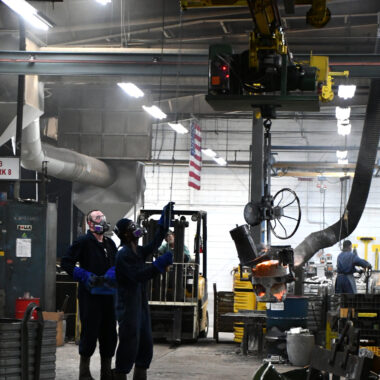Taking Full Advantage Of Performance: Advanced Aluminum Casting Solutions Introduced
Taking Full Advantage Of Performance: Advanced Aluminum Casting Solutions Introduced
Blog Article
Dive Into the World of Light Weight Aluminum Spreading: Understanding the Various Approaches
Aluminum spreading is a basic process in the manufacturing sector, with different methods used to develop complex and accurate elements. Comprehending the different strategies utilized in aluminum spreading can supply beneficial understandings right into the abilities and limitations of each technique. From the standard sand casting approach to the sophisticated die casting procedure, each method provides special advantages depending on the requirements of the task. Discovering these diverse approaches can provide an extensive sight of the possibilities within the globe of aluminum spreading and how each strategy adds to forming the modern production landscape.
Sand Spreading Approach
Sand casting, a widely-used approach in light weight aluminum spreading procedures, includes producing molds made of compacted sand for pouring molten metal. As soon as the mold and mildew is prepared, it is securely placed in a flask and molten light weight aluminum is put right into the tooth cavity.
After the metal has cooled and strengthened, the sand mold and mildew is damaged away to reveal the aluminum spreading. Sand spreading permits the manufacturing of complex forms and big parts that may be costly or tough to create using various other techniques. It is likewise a sustainable strategy as the sand can be recycled and used numerous times, minimizing waste in the casting procedure.
Long-term Mold Strategy

One considerable advantage of the Long-term Mold Technique is the improved dimensional precision it supplies. The steel mold and mildew permits tighter tolerances and finer details in the last light weight aluminum spreadings compared to sand casting methods. This accuracy makes it a recommended option for applications where tight dimensional control is important, such as in the automobile and aerospace industries.

Die Casting Process

Investment Casting Approach
Using a precision spreading technique, Investment Casting description Strategy includes creating detailed aluminum components by pouring liquified metal into a ceramic mold and mildew. This process, additionally understood as lost-wax spreading, starts with the creation of a wax pattern of the preferred component (aluminum casting).
Financial investment casting is generally used for producing parts in industries where complex layouts and limited tolerances are required, such as aerospace, automotive, and medical tools. The versatility and precision of the Investment Casting Technique make it a beneficial strategy in the globe of light weight aluminum spreading.
Lost Foam Spreading Technique
Having actually checked out the detailed accuracy of Investment Casting Approach, the focus now moves to the ingenious approach of Lost Foam Spreading in aluminum component manufacturing. Lost Foam Casting, also known as evaporative pattern casting, is a contemporary method where a foam pattern of the preferred component is produced and afterwards covered with a refractory product. The coated foam pattern is then buried in sand, and molten light weight aluminum is poured right into the mold. As the metal loads the mold and mildew, the foam vaporizes due to the heat, leaving a clean tooth cavity in the form of the preferred component.
Among the major advantages of Lost Foam Casting is its capacity to generate complex forms with detailed details, typically in a single item without the need for additional machining. This approach is likewise known for its high dimensional precision and smooth surface area finish. In Addition, Lost Foam Casting is a cost-effective procedure as it decreases the need for cores and enables the production of light-weight elements. Despite its benefits, Lost Foam Casting calls for cautious control of the casting process to protect against problems and ensure top quality elements.
Final Thought
To conclude, aluminum YOURURL.com casting provides a selection of methods such as sand casting, long-term mold and mildew technique, die casting, financial investment spreading, and shed foam casting. Each technique has its very own advantages and applications, making light weight aluminum casting a versatile and commonly utilized procedure in numerous industries. Recognizing the differences between these approaches is crucial in selecting the most appropriate spreading technique for certain manufacturing needs.
Sand spreading, a widely-used approach in light weight aluminum spreading processes, includes producing molds made of compacted sand for putting liquified metal. aluminum casting.The Long-term Mold And Mildew Strategy, like sand spreading, is an additional widespread approach employed in aluminum casting processes, offering distinct advantages in terms of mold and mildew reusability and dimensional precision. The steel mold and mildew permits for tighter resistances and better information in the final light weight aluminum castings find this contrasted to sand spreading approaches. The 2 primary types of die spreading are cool chamber pass away casting and hot chamber die spreading, each ideal for various kinds of light weight aluminum alloys.In verdict, light weight aluminum spreading uses a range of methods such as sand casting, irreversible mold and mildew strategy, die casting, financial investment casting, and lost foam spreading
Report this page